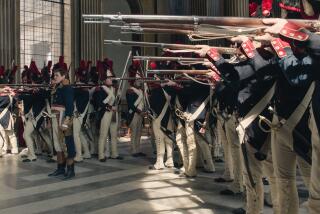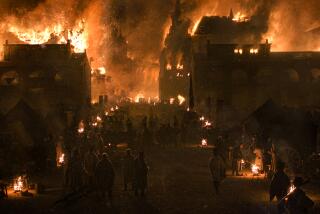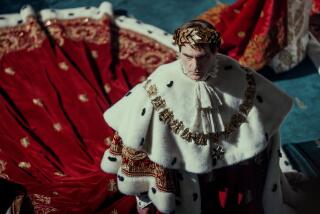Filmmaker Aims for a Complex Napoleon
- Share via
NEW YORK — You may think you know Napoleon, and that is exactly documentary maker David Grubin’s problem.
There have already been more books about Napoleon than any other historical figure, so many so that there are even bookstores that specialize solely in the topic. And the French general and eventual emperor is also the most-chronicled historical figure in movies, including such masterpieces as Abel Gance’s 1927 silent film. New projects continue to appear, including this fall’s major London musical.
Although there have been partial examinations of his legacy, such as TLC’s “Napoleon’s Obsession: The Quest for Egypt” in the spring, strangely, there has never been an in-depth documentary, according to Grubin. That gave the filmmaker, who has chronicled numerous American presidents for PBS’ “American Experience” series, his opening for the four-hour PBS program that is airing in two parts, starting tonight and concluding Nov. 15.
“We all know the name Napoleon and the name Josephine, and we all know he put his hand in his jacket, and that there’s something called the Napoleonic complex,” says Grubin. “But what is lost is the story and the significance of the story. He has become a caricature in our minds. And when people know the story, their eyes pop out of their heads.”
Grubin turned some of the caricature to his advantage, using the “hand-in-the-jacket” myth to explore how Napoleon was his own best public relations person, commissioning portraits of himself in the classic pose. “You know people want to know about the hand and vest, so I felt obliged to put that in the film,” he says.
Mostly, however, he says the form he chooses to work in, long-form historical documentary, allowed him to bring new insight to his oft-chronicled subject. “You’re not going to, in a journalistic sense, come up with something new,” he says. “What you’re really doing is looking for your interpretation of events. No one has ever interpreted him in documentary form. . . . People haven’t experienced the Battle of Waterloo told in documentary form, in a mix of paintings [more than 500 paintings were filmed, from Goya to Ingres] and re-creation” of battle scenes, using an organization of amateur war re-enactors.
The French, he says, tend to approach Napoleon from an abstract, essay standpoint, and filmmakers such as Gance, who was also French, took a romanticized view. Many scholars, he said, tend to take sides: “One book loves him, one book hates him. I felt that I would try to hold both sides of that. I don’t see it as either/or,” says Grubin, who is currently working on a program about the brain and will then tackle the United Nations.
*
Despite an airdate just one day after the presidential election, there’s no significance to the timing of the program, Grubin says; after finishing a portrait of President Abraham Lincoln and his wife Mary (which airs on PBS’ “American Experience” in February), the production company he works with asked him to come up with an international subject so it could get European sales. (Indeed, the production has been sold to French television, an unusual coup.)
But once he got started exploring the history of Napoleon, who came to power in a 1799 coup and then crowned himself emperor in 1804, Grubin says he “began to appreciate how fragile democracy is.” George Washington, who became the first president in 1789, the year the French Revolution began, “left after eight years. . . . Whoever our new president is, we know the old one is going to leave.”
More to Read
The complete guide to home viewing
Get Screen Gab for everything about the TV shows and streaming movies everyone’s talking about.
You may occasionally receive promotional content from the Los Angeles Times.






